Active Driving Assistance package
General notes
The Active Driving Assistance package consists of DISTRONIC PLUS , Active Blind Spot Assist and Active Lane Keeping Assist .
Active Blind Spot Assist
General notes
Active Blind Spot Assist uses a radar sensor system to monitor the side areas of your vehicle which are behind the driver. A warning display in the exterior mirrors draws your attention to vehicles detected in the monitored area. If you then switch on the corresponding turn signal to change lane, you will also receive an optical and audible warning. If a risk of lateral collision is detected, corrective braking may help you avoid a collision. To support the coursecorrecting brake application, Active Blind Spot Assist uses the forward-facing radar sensor system. The free space in the direction of travel is then evaluated.
Active Blind Spot Assist supports you from a speed of approximately 20 mph (30 km/h).
For Active Blind Spot Assist to assist you when driving, the radar sensor system must be:
• activated • operational
Important safety notes
Active Blind Spot Assist is only an aid. It may fail to detect some vehicles and is no substitute for attentive driving.
WARNING
Active Blind Spot Assist does not react to: • vehicles overtaken too closely on the side, placing them in the blind spot area • vehicles approaching and driving by with a speed difference of more than approximately 6.8 mph (11 km/h) As a result, Active Blind Spot Assist may neither give warnings nor intervene in such situations. There is a risk of an accident.
Always observe the traffic conditions carefully, and maintain a safe lateral distance.
USA only: This device has been approved by the FCC as a "Vehicular Radar System".
The radar sensor is intended for use in an automotive radar system only. Removal, tampering, or altering of the device will void any warranties, and is not permitted by the FCC. Do not tamper with, alter, or use in any non-approved way.
Any unauthorized modification to this device could void the user's authority to operate the equipment.
Canada only: This device complies with RSS-210 of Industry Canada. Operation is subject to the following two conditions: 1. This device may not cause harmful interference, and 2. this device must accept any interference received, including interference that may cause undesired operation of the device.
Removal, tampering, or altering of the device will void any warranties, and is not permitted. Do not tamper with, alter, or use in any non-approved way.
Any unauthorized modification to this device could void the user's authority to operate the equipment.
Monitoring area
In particular, the detection of obstacles can
be impaired if:
• dirt on the sensors or anything else
covering the sensors
• poor visibility, e.g. due to fog, heavy rain,
snow or spray
• narrow vehicles, e.g. motorcycles or
bicycles
• the road has very wide lanes
• the road has narrow lanes
• you are not driving in the middle of the lane
• there are barriers or similar lane borders
Vehicles in the monitoring range are then not
indicated.
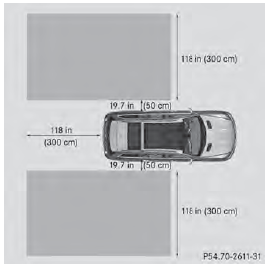
Active Blind Spot Assist monitors the area up to 10 ft (3.0 m) behind your vehicle and directly next to your vehicle, as shown in the diagram. For this purpose, Active Blind Spot Assist uses radar sensors in the rear bumper.
If the lanes are narrow, vehicles driving in the lane beyond the lane next to your vehicle may be indicated, especially if the vehicles are not driving in the middle of their lane. This may be the case if there are vehicles at the inner edge of your lane.
Due to the nature of the system: • warnings may be issued in error when driving close to crash barriers or similar solid lane borders.
• warnings may be interrupted when driving alongside particularly long vehicles, e.g.
trucks, for a prolonged time.
The Active Blind Spot Assist radar sensors are integrated into the front and rear bumpers and behind a cover in the radiator grill. Make sure that the bumpers and the cover in the radiator grill are free of dirt, ice or slush. The rear sensors must not be covered, for example by cycle racks or overhanging cargo.
Following a severe impact or in the event of damage to the bumpers, have the function of the radar sensors checked at a qualified specialist workshop. Active Blind Spot Assist may otherwise no longer work properly.
Indicator and warning display
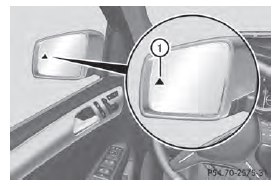
1 Yellow indicator lamp/red warning lamp Active Blind Spot Assist is not active at speeds below approximately 20 mph (30 km/h). Vehicles in the monitoring range are then not indicated.
When Active Blind Spot Assist is activated, indicator lamp 1 in the exterior mirrors lights up yellow at speeds of up to 20 mph(30 km/h). At speeds above 20 mph (30km/h), the indicator lamp goes out and Active Blind Spot Assist is operational.
If a vehicle is detected within the monitoring range of Blind Spot Assist at speeds above 20 mph (30km/h), warning lamp 1 on the corresponding side lights up red. This warning is always emitted when a vehicle enters the blind spot monitoring range from behind or from the side. When you overtake a vehicle, the warning only occurs if the difference in speed is less than 7 mph (12km/h).
The yellow indicator lamp goes out if reverse gear is engaged. In this event, Active Blind Spot Assist is no longer active.
The brightness of the indicator/warning lamps is adjusted automatically according to the ambient light.
Visual and acoustic collision warning
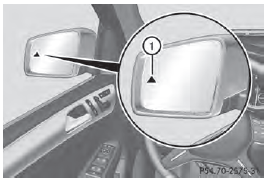
If you switch on the turn signals to change lanes and a vehicle is detected in the side monitoring range, you receive a visual and acoustic collision warning. You then hear a double warning tone and red warning lamp 1 flashes. If the turn signal remains on, detected vehicles are indicated by the flashing of red warning lamp 1. There are no further warning tones.
Course-correcting brake application
WARNING
A course-correcting brake application cannot always prevent a collision. There is a risk of an accident.
Always steer, brake or accelerate yourself, especially if Active Blind Spot Assist warns you or makes a course-correcting brake application. Always maintain a safe distance at the sides.
WARNING
Active Blind Spot Assist does not detect all traffic situations and road users. In very rare cases, the system may make an inappropriate brake application. There is a risk of an accident.
An inappropriate brake application may be interrupted at any time if you steer slightly in the opposite direction or accelerate. Always make sure that there is sufficient distance on the side for other traffic or obstacles.
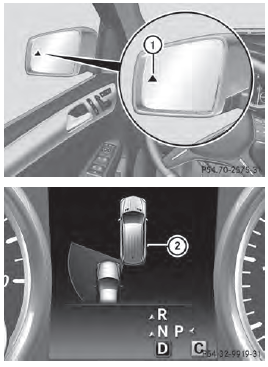
If Active Blind Spot Assist detects a risk of a lateral collision in the monitoring range, a course-correcting brake application is carried out. This is meant to assist you in avoiding a collision.
If a course-correcting brake application occurs, red warning lamp 1 flashes in the exterior mirror and a dual warning tone sounds. In addition, display 2 appears in the multifunction display.
The course-correcting brake application is available in the speed range between 20 mph (30 km/h) and120 mph (200km/h).
Either no braking application, or a coursecorrecting brake application adapted to the driving situation occurs if:
• there are vehicles or obstacles, e.g. crash barriers, located on both sides of your vehicle.
• a vehicle approaches you too closely at the side.
• you have adopted a sporty driving style with high cornering speeds.
• you clearly brake or accelerate.
• a driving safety system intervenes, e.g.
ESP® or PRE-SAFE® Brake.
• ESP® is switched off.
• the off-road program is activated (vehicles without the ON&OFFROAD package).
• off-road program 1 or 2 is activated (vehicles with the ON&OFFROAD package).
• the LOW RANGE off-road gear is activated (vehicles with the ON&OFFROAD package).
• a loss of tire pressure or a defective tire is detected.
Switching on Active Blind Spot Assist
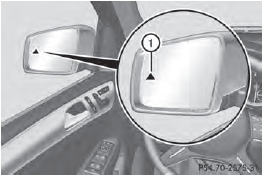
■ Make sure that the radar sensor system and Active Blind Spot Assist are activated in the on-board computer.
■ Turn the SmartKey to position 2 in the ignition lock.
Warning lamps 1 in the exterior mirrors light up red for approximately 1.5 seconds and then turn yellow.
Towing a trailer
When you attach a trailer, make sure you have correctly established the electrical connection. This can be accomplished by checking the trailer lighting. Active Blind Spot Assist is then deactivated. The indicator lamp lights up yellow in the exterior mirrors and the Active Blind Spot Assist Currently Unavailable See Operator's Manual message appears in the multifunction display.
Active Lane Keeping Assist
General notes
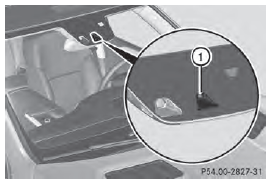
Active Lane Keeping Assist monitors the area in front of your vehicle by means of camera : at the top of the windshield. Active Lane Keeping Assist detects lane markings on the road and warns you before you leave your lane unintentionally. If you do not react to the warning, a lane-correcting application of the brakes can bring the vehicle back into the original lane.
If you select km on the on-board computer in the Display Unit Speed-/Odometer function , Active Lane Keeping Assist is activated starting at a speed of 60 km/h. If the miles display unit is selected, the assistance range begins at 40 mph.
Important safety notes
If you fail to adapt your driving style, Active Lane Keeping Assist can neither reduce the risk of accident nor override the laws of physics. Lane Keeping Assist cannot take into account the road, traffic and weather conditions. Lane Keeping Assist is merely an aid. You are responsible for the distance to the vehicle in front, for vehicle speed, for braking in good time and for staying in your lane.
Active Lane Keeping Assist cannot continuously keep your vehicle in its lane.
WARNING
Active Lane Keeping Assist cannot always clearly detect lane markings.
In such cases, Active Lane Keeping Assist
can:
• give an unnecessary warning and then
make a course-correcting brake application
to the vehicle
• not give a warning or intervene
There is a risk of an accident.
Always pay particular attention to the traffic situation and keep within the lane, especially if Active Lane Keeping Assist alerts you.
Terminate the intervention in a non-critical driving situation.
The system may be impaired or may not
function if:
• there is poor visibility, e.g. due to
insufficient illumination of the road, or due
to snow, rain, fog or spray
• there is glare, e.g. from oncoming traffic,
the sun or reflections (e.g. when the road
surface is wet)
• the windshield is dirty, fogged up, damaged
or covered, for instance by a sticker, in the
vicinity of the camera
• there are no, several or unclear lane
markings for a lane, e.g. in areas with road
construction work
• the lane markings are worn away, dark or
covered up, e.g. by dirt or snow
• the distance to the vehicle in front is too
small and the lane markings thus cannot be
detected
• the lane markings change quickly, e.g.
lanes branch off, cross one another or
merge
• the road is narrow and winding
• there are highly variable shade conditions
on the roadway
• no vehicle is detected in the adjacent lane
and there are broken lane markings
Warning vibration in the steering whee
l
A warning may be given if a front wheel passes over a lane marking. It will warn you by means of intermittent vibration in the steering wheel for up to 1.5 seconds.
In order that you are warned only when necessary and in good time if you cross the lane marking, the system recognizes certain conditions and warns you accordingly.
The warning vibration occurs earlier if: • you approach the outer lane marking on a bend.
• the road has very wide lanes, e.g. a freeway.
• the system recognizes solid lane markings.
The warning vibration occurs later if: • the road has narrow lanes.
• you cut the corner on a bend.
Lane-correcting brake application
WARNING
A lane-correcting brake application cannot always bring the vehicle back into the original lane. There is a risk of an accident.
Always steer, brake or accelerate yourself, especially if Active Lane Keeping Assist warns you or makes a lane-correcting brake application.
WARNING
Active Lane Keeping Assist does not detect traffic conditions or road users. In very rare cases, the system may make an inappropriate brake application, e.g. after intentionally driving over a solid lane marking. There is a risk of an accident.
An inappropriate brake application may be interrupted at any time if you steer slightly in the opposite direction. Always make sure that there is sufficient distance on the side for other traffic or obstacles.
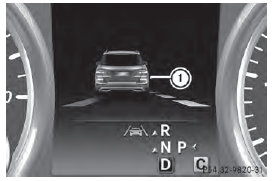
If a lane-correcting brake application occurs, display 1 appears in the multifunction display.
If you leave your lane, under certain circumstances the vehicle will brake briefly on one side. This is meant to assist you in bringing the vehicle back to the original lane.
This function is available in the range between 40 mph and 120 mph (60 km/h and 200 km/h).
A lane-correcting brake application can only be made after driving over a solid, recognizable lane marking. Before this, a warning must be given by means of intermittent vibration in the steering wheel.
In addition, a lane with lane markings on both sides must be recognized. The brake application also slightly reduces vehicle speed.
A further lane-correcting brake application can only occur after your vehicle has returned to the original lane.
No lane-correcting brake application occurs
if:
• you clearly and actively steer, brake or
accelerate.
• you cut the corner on a sharp bend.
• you have switched on the turn signal.
• a driving safety system intervenes, e.g.
ESP®, PRE-SAFE® Brake or Active Blind Spot Assist.
• you have adopted a sporty driving style with high cornering speeds or high rates of acceleration.
• ESP® is switched off.
• the transmission is not in position D.
• on vehicles with a trailer tow hitch, the electrical connection to the trailer has been correctly established.
• the off-road program is activated (vehicles without the ON&OFFROAD package).
• off-road program 1 or 2 is activated (vehicles with the ON&OFFROAD package).
• the LOW RANGE off-road gear is activated (vehicles with the ON&OFFROAD package).
• a loss of tire pressure or a defective tire has been detected and displayed.
Active Lane Keeping Assist does not detect traffic situations or road users. An inappropriate brake application may be interrupted at any time if you: • steer slightly in the opposite direction • switch on the turn signal • clearly brake or accelerate A lane-correcting brake application is interrupted automatically if: • a driving safety system intervenes, e.g.
ESP®, PRE-SAFE® Brake or Active Blind Spot Assist.
• lane markings can no longer be recognized.
Switching on Active Lane Keeping Assist
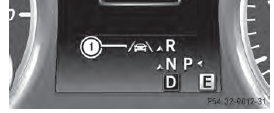
■ Switch on Active Lane Keeping Assist using the on-board computer; to do so, select Standard or Adaptive .
Symbol 1 appears in the multifunction display.
If Standard is selected, no warning
vibration occurs if:
• you switch on the turn signals. In this
event, the warnings are suppressed for a
certain period of time.
• a driving safety system intervenes, such as ABS, BAS or ESP®.
If Adaptive is selected, no warning
vibration occurs if:
• you switch on the turn signals. In this
event, the warnings are suppressed for a
certain period of time.
• a driving safety system intervenes, e.g.
ABS, BAS or ESP®.
• you accelerate hard, e.g. kickdown.
• you brake hard.
• you steer actively, e.g. swerve to avoid an obstacle or change lanes quickly.
• you cut the corner on a sharp bend.
Towing a trailer
When you attach a trailer, make sure you have correctly established the electrical connection. This can be accomplished by checking the trailer lighting.
See also:
Combination switc
Turn signals
1 High-beam headlamps
2 Turn signal, right
3 High-beam flasher
4 Turn signal, l
► To indicate briefly: press the combination
switch briefly to the pressure point in the
dir ...
Unlocking and opening doors from
the inside
You can open a door from inside the vehicle even if it has been locked. You
can only open the rear doors from inside the vehicle if they are not secured by
the child-proof locks .
If the ve ...
Pulling away
Automatic transmission
WARNING
If the engine speed is above the idling speed
and you engage transmission position D or
R, the vehicle could pull away suddenly. There
is a risk of an accident.
...
